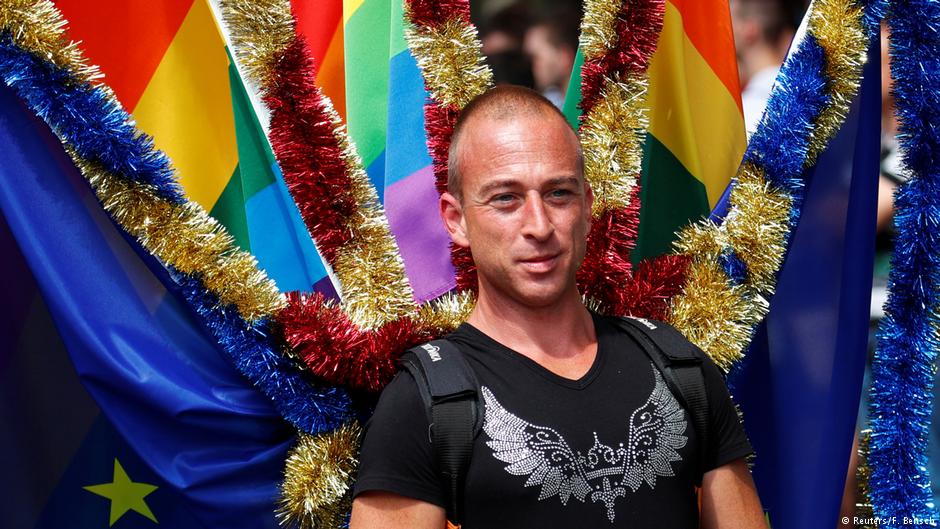Clearly, there is something about the plays of Eugene Ionesco that lend themselves to an Egyptian context. Perhaps this is why two of them appear in the five performances of Downtown’s 2B Continued Festival of Theater and Dance this week. It is perhaps also why director Ahmed Shawky El-Bohy chose to tailor his adaptation of “Amedee or How to Get Rid of It” to clear references about Mubarak’s regime, in this play about a couple living with a growing corpse in their home.
The title, “Amedee, or How to Get Rid of It” refers to a couple’s efforts to deal with the weeds, grass shoots, and what are, in Ionesco’s original version (1954), the mushrooms sprouting from an otherwise perplexingly present corpse, threatening to take over the unhappy couple’s home.
Amedee, played by Ahmed Abdul Atey El-Sayed, is a whimsical yet frustrated writer whose work revolves around the one line he has written about an old man standing to give a speech. He cannot move past this sentence. His wife, Madeline, played by Dalia El-Guindy, is the breadwinner of the family, and her unhappiness with their situation and their poverty is overwhelming. She is terminally bitter.
For “29 years!” the corpse has been in their home, Amedee shouts. This reflects the directors rewording of the original text to correspond with the number of years that president Hosni Mubarak has been in office. That the corpse is growing and growing, is taciturnly dealt with in shifts of physical action and terse exchange. Its presence is the axis upon which this absurdist drama revolves. But unlike the Ionesco comedy of the night before, El-Bohy’s adaptation is tense and deadpan; there is little light, literally or figuratively within the evening’s dark subject.
How the corpse has arrived is the one comedic exchange that occurs near the end of the piece —Madeline offers that Amedee has murdered a past lover. Amedee retorts among other farcical that his murder of a baby that is growing and growing is what has got the neighbors wondering.
Where the play works is in the strong timing of the actors, their onstage relationship, their ability to hold the stage throughout the play’s duration, the entire first half of the evening. Where it falls short is in the places where the action seems to exist at a stalemate — the corpse is growing, but there is little dramatic action to signify a change from the play’s first moments to its last. This is the trouble of the writing: Ionesco’s work in the text functions to create a poetic unfolding. It is possible also that this is the director’s intention — the lack of shift in a brutal, disgusting situation keeps the couple (and the country) from simply reacting and tending the damage.
In certain versions, Ionesco’s play ends with Amedee being dragged by the corpse out to sea. In other’s the corpse takes over the stage. In El-Bohy’s production, Madeline and Amedee work like sailor’s pushing the very walls of their home, using ropes to hoist out the corpse. The final spotlight goes down on the couple, pulling and pulling in a futile gesture.
The evening’s two performances, “Amedee” and “Galatea’s Twilight” choreographed by Maha Elmarraghi, echo the combination of the night before them: Ionesco theater and an abstract experimental modern dance piece. What differs is the note and tenor upon with which each performance is presented. In Elmarraghi’s work, there is a distinct shift to the mature and thoughtful in dance.
The name Galatea connotes the legend of a statue come to life, the opening image of Elmarraghi’s performance. The multi-media work begins on a stage scattered with ruins, echoing an image from a Salvador Dali painting. The black floor is strewn with sculptural carnage: the white torso of an upturned statue, the white wire of a bust, hollow frames of pictures that are no longer present. The two dancers begin in this midst of this environment. Aga Miley stands covered in a white sheet like a ghost. Mohamed Fouad moves her about as if she were a piece of furniture. Soon she comes to life.
The two then engage in a passionate physical duet, drawing on the methods of Contact Improvisation and balletic partnering. Fouad is agile, elegant and amazingly energetic; he spreads his body across the floor as freely as he does across the space. The couple is at once frenzied, fighting and sensual. Miley wears diaphanous materials. The cloths, white and black, flow around her as she moves in a series of stations — her performance is one of will and resistance to her lover. The highlight of this performance is the onstage presence of two musicians; Nancy Mounir on viola and Dina El-Wedidi on vocals.
The musicians create a lush and haunting soundscore for the dance’s unfolding. El-Wedidi’s strong, gorgeous voice is at once soothing and inciting. Mounir’s instrument is invaluable in its levels of sophistication. Together, the two present a toned down version of a popular Egyptian song about a woman bereft in her relationship; it is sung slowly and insightfully adapted to the performance. The dance is a series of separate performances; between the musicians, between the couple, between the male alone, and ends with the female reaping destruction to the frames of her life.
This is achieved quite literally with Miley walking about the stage knocking things over. This overt show of what might have been achieved more subtly within this poetic context is the shortcoming of an otherwise strong debut for choreographer Elmarraghi.
The third edition of the 2B Continued Laboratory & Festival of Theater and Contemporary Dance is presented at the Falaki Theater, Downtown Cairo, 8pm. The festival concludes on Tuesday, January 18. Admission is free.


